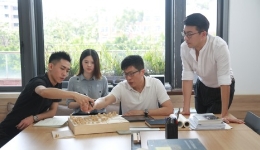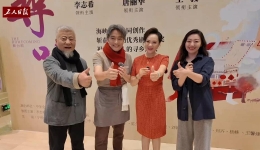Original title: Rui Rabbit Cultural Relics Stories
"The little white rabbit is white and white, and its ears stand up; it likes to eat carrots and vegetables, and it is really cute to bounce." 2023 is the year of Guimao (rabbit) in the lunar calendar. In Chinese traditional culture, the rabbit is not only one of the twelve zodiac signs, but also regarded as an auspicious thing, so it is very popular. There are many rabbit relics left in ancient times, and the image of the rabbit is cute or agile.
Red Rabbit Darui White Rabbit Zhongrui
The word "rabbit" and the record of rabbit are found in the oracle bone inscriptions of the Shang Dynasty. The rabbit shaped jade ornament of the Western Zhou Dynasty unearthed from Liulihe, Fangshan, Beijing, is blue, yellow, white, black, brown, hard and partially translucent. The rabbit runs like a runner, with protruding eyes, tight mouth, long ears, arched forelegs, pedaled hind legs, and cocked tail. It has a vivid shape, 3.5 cm long.
It is recorded in the ancient book "Ruiying Map" that "a red rabbit is lucky, and a white rabbit is lucky." If you can take a white rabbit across the ancient times, you should sing and dance to the imperial court, which means that the monarch is wise, and the domestic governance is great. Maybe you can be appointed an official. It is recorded that in the first year of Jianping, the third year of Yonghe and the first year of Yongkang in the Han Dynasty, white rabbits were presented to the court.
In ancient times, most of the wild rabbits were grayish brown, while white rabbits were rare, which was a variation phenomenon. Therefore, they were considered as "Zhongrui" dedicated to the emperor. Of course, red rabbits are even rarer. Therefore, it is said that "the dragon and phoenix among people, the red rabbit among horses". Lv Bu's "red rabbit horse" can be regarded as a masterpiece among horses. Rabbit is not only an auspicious thing, but also a symbol of longevity. The legend of rabbit in the middle of the month has a long history. Because of its meaning of auspiciousness and longevity, there are many rabbit relics left in ancient times, including porcelain, jade, wood, crystal and other materials.
Rabbits are closely related to human history
Rabbits are closely related to human history. The fossils of rabbitiform mammals, including hares and pikas, were found at the Peking Man site in Zhoukoudian, which is 500000 years ago. The fossils of Mongolian grass hare were found at the ancient human activity site of Wangfujing Dongfang Square 24000 years ago. At that time, they were on the human diet.
Since the Tang Dynasty, due to the development and popularity of the concept of the twelve zodiac signs, many epitaphs or tomb walls are carved or painted with the twelve zodiac signs. "Mao Rabbit" is absolutely necessary.
The epitaph of the Tang Dynasty found in Xicheng District has a bucket shaped cover and four characters of "Zhao Gong's epitaph" in regular script in the middle. Four kills (corners) are carved with precious flowers, and four sides (three on each side) are carved with twelve zodiac figures with animal heads and human bodies. Each Chinese zodiac has his hands around his waist in a respectful manner. The head of the zodiac is one of the twelve zodiac signs, and the rabbit appears at nine o'clock. The rabbit has its head left, wears a long gown and high shoes, and carries a chaolut, a civil official image.
The Liao Dynasty crystal rabbit unearthed in Tongzhou is in a recumbent shape, with ears, eyes, mouth, claws, etc. Although it is simply carved with a few knives, it is vivid. The rabbit ornament is 2cm high, 3cm long and 1.1cm wide. Its lines are simple, steady, slim, vivid, charming, and has holes under the neck. This artifact should be a necklace pendant worn by a woman, and it is a masterpiece of crystal carving in the Liao Dynasty.
"Moving like a rabbit" means that the rabbit runs very fast. The word "Yi" literally means "walking rabbit". Rabbits run faster than horses, reaching more than 70 kilometers per hour. No wonder the ancients used the word "Yi" to mean galloping. The rabbit in the murals of the Jin Dynasty in Shijingshan has upright ears, runs forward quickly, and the tail is up. Unfortunately, the picture is damaged, but the rabbit can also feel the speed of rising and rising.
The jade rabbit pounding medicine is an important theme in ancient myths and legends. The picture of Chang'e Moon Palace has always been displayed, and an image of the jade rabbit pounding medicine is indispensable to show the yearning for immortality. The jade rabbit was seen in the Han Yuefu's Dong Escape. It is said that there is a rabbit in the moon, whose whole body is as white as jade, so it is called "Jade Rabbit". Fu Xuan of the Jin Dynasty said in the book "Imitating the Sky": "What happens in the middle of the month? White rabbits pound medicine."
The jade rabbit earrings for pounding medicine unearthed in the Dingling Tomb of the Ming Dynasty are carved from blue and white jade. The rabbit's ears are vertical, with rubies embedded as eyes. It is upright, with two front paws holding the pestle to make the shape of pounding medicine. There is a mortar under it, and the rabbit's body is carved with hair with fine lines. The jade rabbit steps on three cloud head shaped gold brackets, with opal in the center and rubies on both sides. The overall length of the bracket is 5.8cm, and the rabbit is 2.4cm high. The whole earring has a unique and gorgeous shape.
The Ming Dynasty porcelain basin unearthed in Xicheng District is in Cizhou kiln style, but it is incomplete. However, the Palace Museum has a white ground and black flower rabbit pattern basin of Pengcheng Kiln in the Ming Dynasty, which can give you a panoramic view.
The flower gilded horizontal rabbit mirror frame of the Ming Dynasty shows that the rabbit is lying on its side, with its head raised, its eyes bright, its ears erect, its mouth holding the Ganoderma lucidum handle, and the handle is wrapped behind it, and the Ganoderma lucidum rises. The front and rear limbs are extended, and the small tail is turned upward. Ganoderma lucidum and hind limbs are used to support the bronze mirror. The whole body is gilded at intervals to show the luster of rabbit hair. This frame is practical and beautiful, and is a rare exquisite artwork.
White Rabbit gives birth to a son. Congratulations
The white and white rabbit was chanted by many poets in ancient times. The Han Yuefu poem "Ancient Yange": "Alone white rabbit, look around. The clothes are not as new as before, and people are not as old as before." It describes an abandoned woman, just like the lonely and helpless white rabbit wandering in the wild, which makes people feel sorry. There is a poem in One Hundred Palace Lyrics written by Wang Jian, a court poet of the Tang Dynasty: "The white rabbit in the new autumn is bigger than its fist, and its red ears, frost and hair sleep on the grass. The emperor does not teach people to shoot, and the jade whip covers the horse's hooves." Because the little white rabbit is so young and sleepy, the emperor cannot bear to kill it. The White Rabbit written by Ouyang Xiu of the Song Dynasty: "The white rabbit pounded the medicine in the Tu'e Palace, and the jade pass was locked at night." Even in the History of the Ming Dynasty, it was recorded that "the white rabbit gave birth to a son in Xinmao in the spring and March of the 41st year of (Jiajing), and the officials asked the temple, (Jiajing Emperor) Xu Zhi, and the officials congratulated him." A white rabbit gave birth to a baby, and the officials congratulated him, which sounds inconceivable today.
The Palace Museum has a blue and white plate with white rabbit pattern of three friends in the Ming Dynasty. The inside wall of the plate is painted with blue and white flowers with patterns of three friends in the pine, bamboo and plum years. The center of the plate is painted with a blue and white circle with white rabbit pattern, just like a rabbit lying in a full moon. The outsole is printed in blue and white with six character double line pattern of "made in Xuande year of the Ming Dynasty", which is very different from the style of Xuande's model year. This plate of blue and white is blue and purple in color, rich and beautiful, and has a slim body. Therefore, this porcelain plate should be an imitation of the Longqing Dynasty.
In Du Fu's poem "The Moon", there is a sentence that "the toad will not disappear when entering the river, and the rabbit will live forever when pounding medicine", describing the moonlight of the Mid Autumn Festival. The shape of the jade rabbit painted on this plate is just poetic, or has a beautiful implication of wishing people a long life and praying for reunion. The rabbit pattern, together with pine, bamboo and three friends of the plum age, is painted on the same object, which adds a bit of elegance and interest to this small plate of folk kilns in the late Ming Dynasty.
The Qing Dynasty jade rabbit pendant unearthed in Dongcheng District is gentle and kind. The rabbit crawls on the ground and treads on lentils. This jade pendant is exquisitely made by skillfully using different colors on the jade.
The animal heads of the twelve Chinese zodiac signs of the Qing Dynasty in front of the Haiyan Hall in the Old Summer Palace are commonly known as water clocks. These animal heads are made of copper and spray water from their mouths every two hours. They are treasures of the blending of Chinese and Western cultures. They have been lost overseas for a long time, and now the rabbit head has returned to China. The rabbit's head is round, its eyes are erect, and its ears are three valves.
Ji Kun, a native of the Ming Dynasty, said, "The Mid Autumn Festival in Beijing is usually held in the shape of a rabbit made of mud, dressed like a man, and worshipped by sons and daughters." In the Yanjing Chronicles of Age, it was recorded that "every Mid Autumn Festival, people who are skillful in the city use yellow mud to make a toad rabbit for sale, which is called the Rabbit God." Rabbit God is a traditional toy of the Mid Autumn Festival, which originated from the traditional Chinese activities of worshiping the moon god, Old Beijingers also call it "Long Eared Immortal". It is said that the jade rabbit is used to pound medicine to cure people's diseases and disasters, and people have created a colorful image of the rabbit master. These painted clay figurines of Rabbit God are not in the same style, but the characteristics of three petal mouths and long ears are the most common.
From the image of the jade rabbit in the Western Zhou Dynasty, to the crystal rabbit in the Liao Dynasty, to the theme of making medicine with the jade rabbit in the Ming Dynasty, and to the Mid Autumn Festival "rabbit master" with various shapes since the late Qing Dynasty, the meaning and content of the jade rabbit, in addition to the auspicious omen, has become more and more broad in specific situations.
Author: Guo Jingning Beijing Institute of Archaeology













